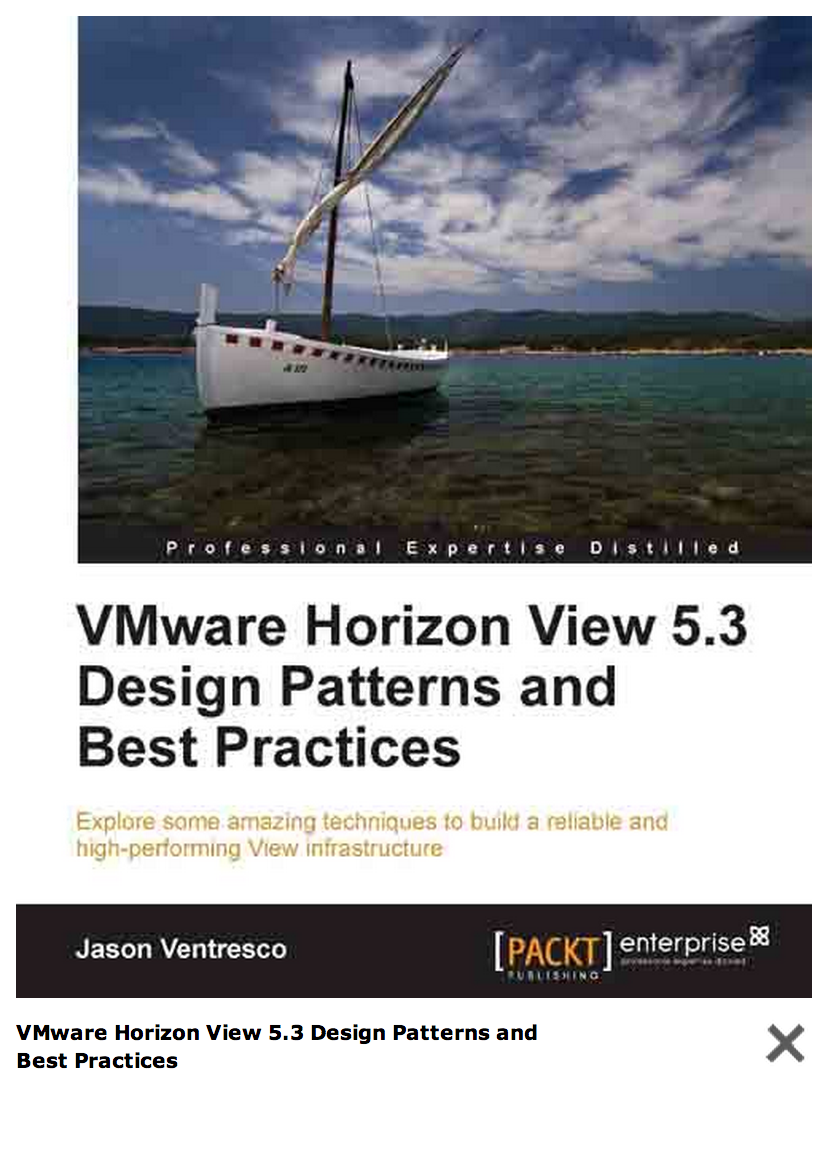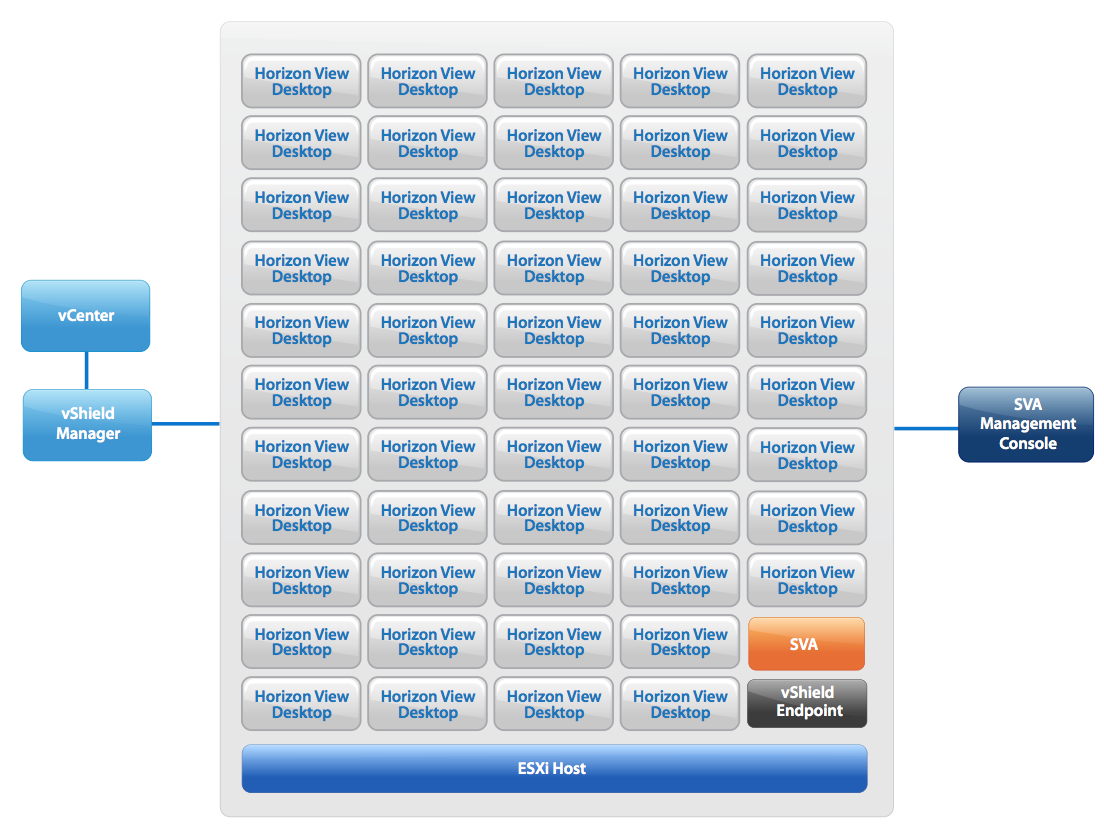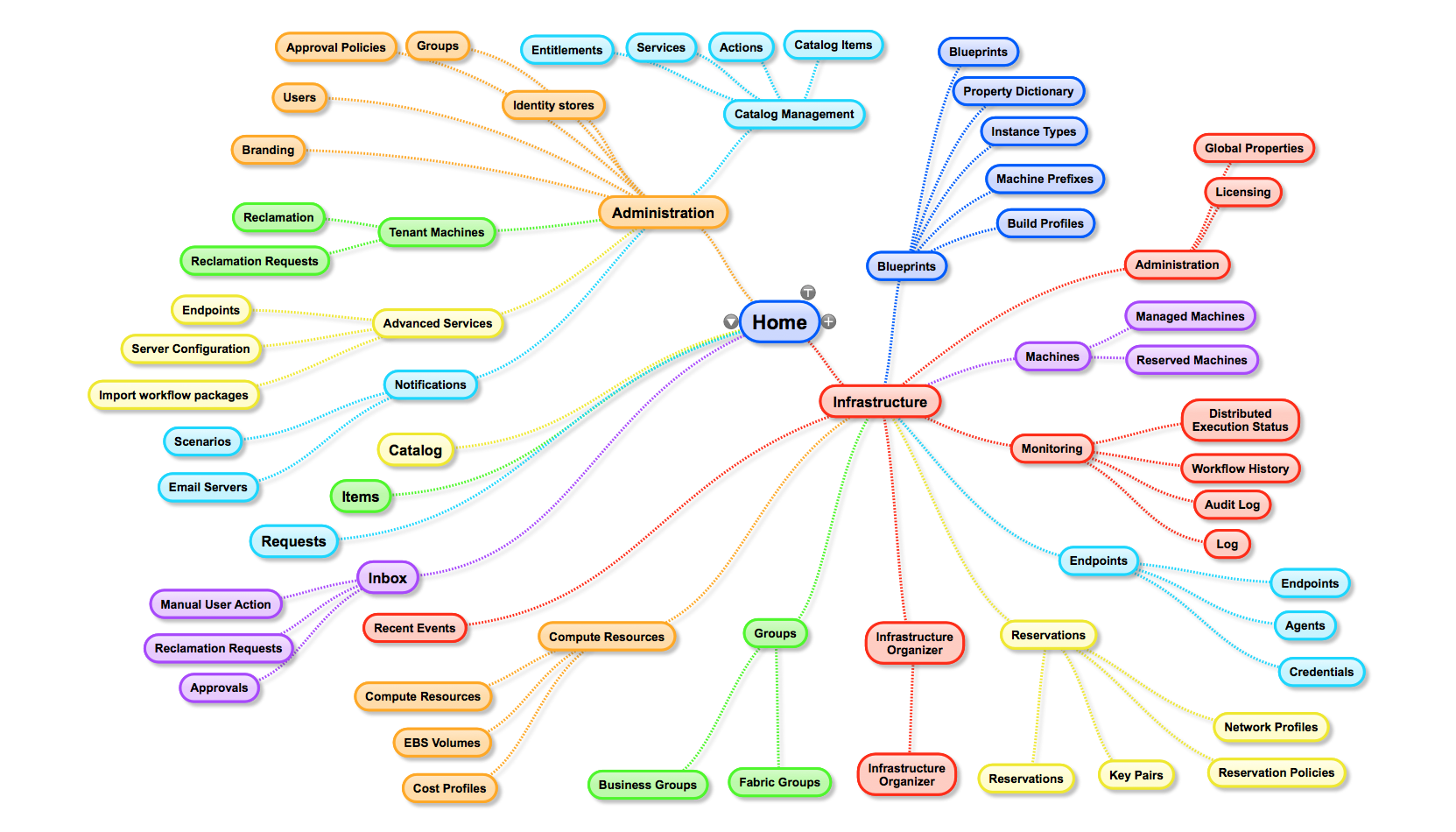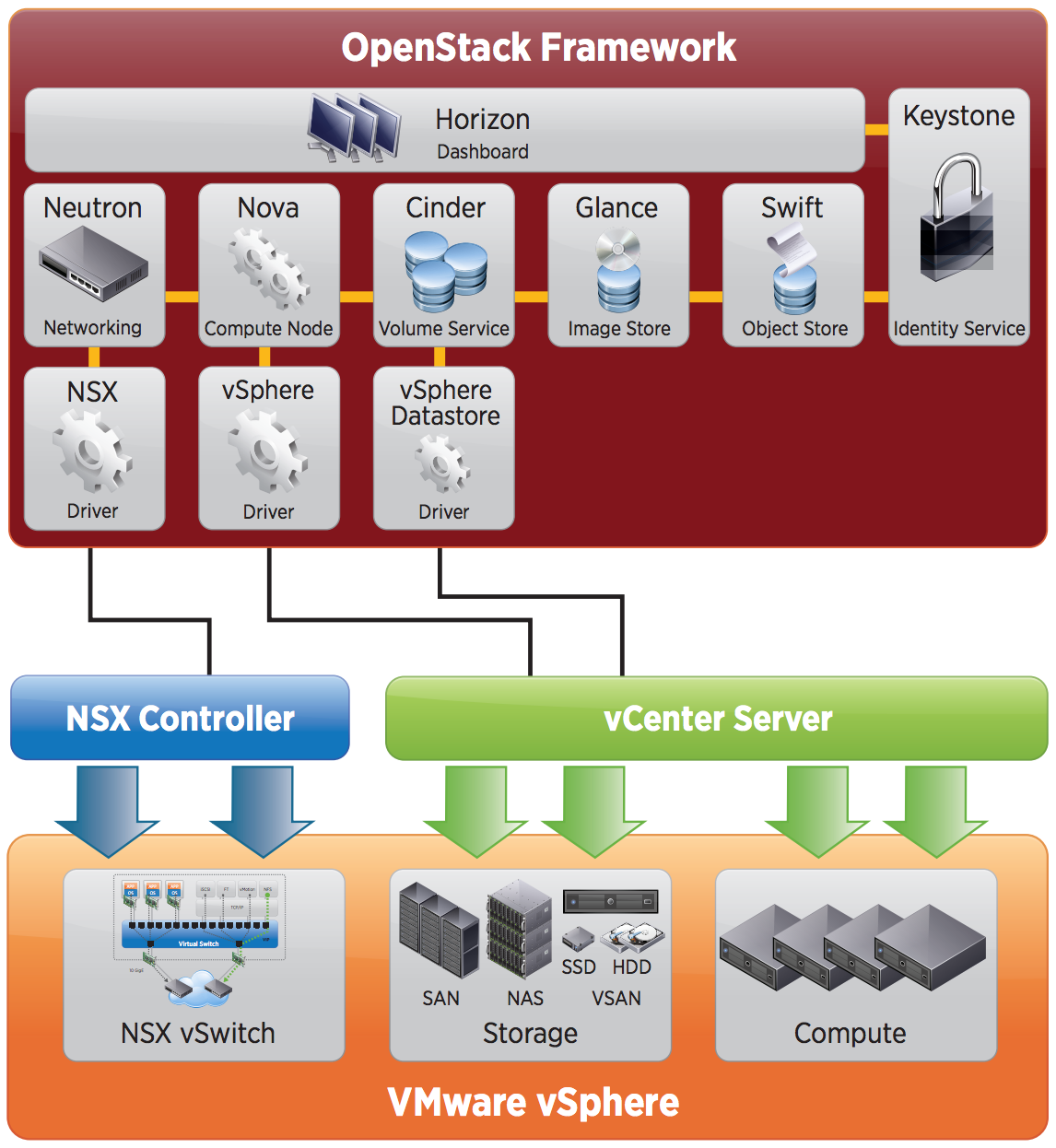Friday, January 24. 2014
10 New VMworld 2013 Session Videos Online at VMworld TV
New Book - VMware Horizon View 5.3 Design Patterns and Best Practices

Building a Horizon View infrastructure isn’t just about buying the right hardware; it requires careful consideration of all layers of the implementation including desktop pool configuration, the ability to monitor and troubleshoot the environment, and understanding what will happen when the environment matures or is required to expand. This book will help you understand why each of these topics is important, and provide the guidance needed to help make your Horizon View environment successful.
Virtualizing Active Directory Domain Services On VMware vSphere
This technical white paper provides best practice guidelines for deploying AD DS on vSphere. The recommendations in this guide are not specific to a particular set of hardware or to the size and
scope of a specific AD DS implementation.The examples and considerations in this document
provide guidance, but do not represent strict design requirements.
As the prominent directory service and authentication store, Active Directory Domain Services
(AD DS) is in the majority of network infrastructures. In some environments AD DS is viewed as
another required service, but it does not attract much attention. In other environments AD DS is
treated as the business critical application (BCA) that it is.
Considering that the ability to access
network resources and the Internet, look up user information, and use email often requires AD
DS, it is worth understanding the importance of this service and the stability of its underlying
infrastructure.
In much the same way that the criticality of AD DS differs from organization to organization, so
does the acceptance of virtualizing this service.
More conservative organizations choose to
virtualize a portion of the AD DS environment and retain a portion on physical hardware. The
cause is typically misinformation, lack of experience in virtualization, or fear of the unknown.
With the release of Windows Server 2012, new features alleviate many of the legitimate concerns
that administrators have about virtualizing AD DS. These new features, the latest versions of
VMware®
vSphere®
, and recommended practices help achieve 100 percent virtualization of AD
DS.
Download: Virtualizing Active Directory Domain Services On VMware vSphere
Wednesday, January 22. 2014
VMware has released the vSphere 5.5 Based VCP Exam
Passing either of these exams will earn VCP5-DCV certification if you have also taken an approved qualifying course.The VMware Certified Professional 5 – Data Center Virtualization (VCP5-DCV) Exam tests candidates on their skills and abilities installing, configuring and administering a VMware vSphere 5 environment. Successful candidates demonstrate mastery of these skills and abilities.
This exam contains new content on vSphere version 5.5, so please prepare accordingly. The VCP5-DCV Exam consists of 135 questions and a short pre-exam survey consisting of 8 questions. The passing score for this exam is 300, using a scaled scoring method. The scale is from 100-500. Scaled scores are calculated using a mathematical formula that considers a variety of factors, including the number and type of exam questions included in a specific version of the exam.
Monday, January 20. 2014
Get 50% discount on a VMware Certified Associate (VCA) exam
VMware has released three new certifications. There's no training course requirement for the new exams although VMware offers a free self-paced eLearning course which is recommended to help you prepare for the VCA exams. Earning VMware Certified Associate (VCA) certification demonstrates your foundational understanding of virtualization technology.
VMware Certified Associate - Cloud (VCA-Cloud)
With the VCA-Cloud certification, you’ll have greater credibility when discussing cloud computing, the business challenges the vCloud Suite is designed to address, and how deploying the vCloud solution addresses those challenges. You'll be able to define cloud computing and provide use case scenarios of how vCloud and cloud computing can take advantage of private and public clouds without changing existing applications and leverage a common management, orchestration, networking, and security model.
To become VCA-Cloud certified you must pass the VCA-Cloud exam (exam code: VCAC510). There is no training requirement, however there is a free, self-paced e-learning class that can help you prepare: VMware Cloud Fundamentals
VMware Certified Associate - Data Center Virtualization (VCA-DCV)
With the VCA-Data Center Virtualization certification, you'll have greater credibility when discussing data center virtualization, the business challenges that vSphere is designed to address, and how virtualizing the data center with vSphere addresses those challenges. You'll be able to define data center virtualization and provide use case scenarios of how vSphere and data center virtualization can provide cost and operational benefits.
There is no training requirement, however there is a free, self-paced e-learning class that can help you prepare: VMware Data Center Virtualization Fundamentals
VMware Certified Associate - Workforce Mobility (VCA-WM)
With the VCA-Workforce Mobility certification, you’ll have greater credibility when discussing workforce mobility and end-user computing, the business challenges that VMware Horizon Suite is designed to address, and how deploying the Horizon solution addresses those challenges. You will be able to define workforce mobility and provide use case scenarios of how Horizon and workforce mobility can deliver freedom, flexibility, and manageability while connecting people to their data, applications, and desktops.
This free, self-paced eLearning course is recommended to help you prepare for the VCA-WM exam, but is not required: VMware Workforce Mobility Fundamentals
VMware Certified Associate - Network Virtualization (VCA-NV)
With the VCA-Network Virtualization certification, you’ll have greater credibility when discussing network virtualization, the business challenges network virtualization is designed to address, and how deploying the VMware network virtualization solution addresses those challenges. You'll be able to define network virtualization and provide use case scenarios of how network virtualization can enhance the cost and operational benefits of virtualization across your network.
After booking the exam, it will be available for two days. The length of the exam is 90/120 minutes. When you take the exam before 31 January, 2014, you will get a discount of 50%. The normal price is 95.00, after discount it's only EUR 57.47 (inclusive VAT). The exam can be taken online from home and you may cancel this exam as long as the exam has not been started, and the delivery period has not expired.
There's a special promotion that expires on 31 January, 2014 - The 50% discount on a VMware Certified Associate (VCA) exam promotion code is: VMRT7A0D9F9B
Enabling VMware vShield Endpoint in a VMware Horizon View Environment
The performance problems caused by AV software are compounded in large implementations. When many people log in around the same time, waking up dormant virtual machines and triggering simultaneous antivirus signature updates, the resulting I/O problems—login and AV storms—become time-consuming and inconvenient, to say the least.
Even with improved scheduling and other techniques designed to mitigate their effects, these I/O problems downgrade the typical user experience and precipitate expensive service calls. They are capable of bringing VDI performance to a grinding halt.

VMware vShield Endpoint addresses the problems of antivirus scanning in a large-scale virtual desktop implementation with a better solution: It consolidates and offloads all antivirus and associated operations into a centralized security virtual appliance (SVA), supplied by a VMware partner.
The SVA runs and manages antivirus software as a dedicated virtual machine on the hypervisor, with very small desktop drivers. This replaces dozens or hundreds or thousands of large AV agents on individual virtual desktops.
New technical white paper: Enabling VMware vShield Endpoint in a VMware Horizon View Environment
Thursday, January 16. 2014
vCloud Automation Center 6 - Mind Map
 VMware vCloud Automation Center enables IT organizations to deliver services to their lines of business in a simple, yet highly configurable, self-service experience.
vCloud Automation Center provides a secure portal where authorized administrators, developers or business users can request new IT services as well as manage specific cloud and IT resources, while ensuring compliance with business policies.
VMware vCloud Automation Center enables IT organizations to deliver services to their lines of business in a simple, yet highly configurable, self-service experience.
vCloud Automation Center provides a secure portal where authorized administrators, developers or business users can request new IT services as well as manage specific cloud and IT resources, while ensuring compliance with business policies. Requests for any IT service — including infrastructure, applications, desktops, and many others — are processed through a common service catalog to provide a consistent user experience. In addition, vCloud Automation Center improves cost control by providing visibility into the cost of cloud resources and provides simplified resource management including reporting on capacity usage. This documentation center describes how to install, configure, and leverage vCloud Automation Center features to meet your business needs.
Wednesday, January 15. 2014
New Training Course - VMware Virtual SAN: Deploy and Manage
This training course focuses on deploying and managing a software-defined storage solution with VMware Virtual SAN 5.5. This course looks at how Virtual SAN is used as an important component in the VMware software-defined data center. The course is based on VMware ESXi 5.5 and VMware vCenter Server 5.5.
By the end of the course, you should be able to meet the following objectives:
- Define the key components of a software-defined data center
- Identify benefits of software-defined storage solutions
- Compare and contrast disk types and storage technologies
- Explain file, block, and object-oriented storage
- Identify Virtual SAN requirements, use cases, and architecture components.
- Plan and design a Virtual SAN deployment
- Configure Virtual SAN clusters
- Identify benefits of storage policy-based management
- Scale a Virtual SAN deployment based on storage needs
- Monitor Virtual SAN
- Troubleshoot Virtual SAN
- Identify the integration of Virtual SAN with the VMware product portfolio
Register for the first beta delivery here: VMware Virtual SAN: Deploy and Manage
Securing Virtual Appliances to Meet High Governance Requirements
The purpose of the hardened virtual appliance operations guide is to address the remaining technical requirements that are site-specific decision required to meet the STIG. This document is intended for advanced level administrators, and should be read before deploying hardened virtual appliances in a production environment.
Hardened Virtual Appliance Operations Guide - Securing the Appliance Base Platform to Meet High Governance Requirements
Getting Started with OpenStack and VMware vSphere
vSphere has a long history of being a stable and resilient platform that offers many benefits to host cloud infrastructures. As an enterprise-class hypervisor with production-level features and support, vSphere is an excellent solution for enhancing OpenStack. Many vSphere features facilitate the implementation of OpenStack by simplifying configuration and reducing the number of steps required to provide resources.

vSphere platform capabilities are exposed to OpenStack using drivers that map OpenStack requests into equivalents that VMware solutions can interpret. VMware provides these drivers to the OpenStack community free of charge. Drivers for Cinder and Nova, illustrated in Figure 2, are examples. Significant effort is being applied to the creation of additional drivers, such as one that leverages VMware NSX™ to provide advanced networking functionality via Neutron.





